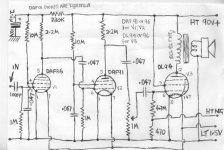For somewhat more output power, you could also tinker with the 3A4/DL93/CV807/2P3 power tube, the big block among the battery valves. Or you could use the Russian 1P29 rod tube, as Thomasha did in his similar project.
Best regards!
Best regards!
Thanks for the reply.
I want to keep the original valves, so I think I will have to live with the low power. Maybe they will give that overdriven valve tone at low volume!
Kind regards,
Pedro
I want to keep the original valves, so I think I will have to live with the low power. Maybe they will give that overdriven valve tone at low volume!
Kind regards,
Pedro
On post #10, Thomas shared a video of a battery powered radio converted into a guitar amplifier.
If we look at the schematic (attached), they keep things simple and just connect 1.5V batteries to the heaters.
Maybe I am being silly trying to do it differently.
What I would like to do is to bias the first preamp valve hot (close to 0V), so it can clip by saturation and then, the second valve is biased cold so it can clip by cut-off.
The power valve, should not clip at all, or only clip on the side that is already clipped while keeping the other lobe clean, so we can get asymmetric clipping.
This is non-sense in this amp, right? Should I keep it simple, as in the schematic attached?
Kind regards,
Pedro
If we look at the schematic (attached), they keep things simple and just connect 1.5V batteries to the heaters.
Maybe I am being silly trying to do it differently.
What I would like to do is to bias the first preamp valve hot (close to 0V), so it can clip by saturation and then, the second valve is biased cold so it can clip by cut-off.
The power valve, should not clip at all, or only clip on the side that is already clipped while keeping the other lobe clean, so we can get asymmetric clipping.
This is non-sense in this amp, right? Should I keep it simple, as in the schematic attached?
Kind regards,
Pedro
Attachments
It would be worth trying, maybe not easy to accomplish only using the battery.
I would strongly suggest, if you go down this route, you use a ICL7660 circuit to obtain different grid bias.
This way you can also remove it, if you want to go back to the normal bias.
If you add a good sensitive speaker (don't know if a MOD 6" would fit) it can get pretty loud, even with only some mW (for living room levels, at least).
I would strongly suggest, if you go down this route, you use a ICL7660 circuit to obtain different grid bias.
This way you can also remove it, if you want to go back to the normal bias.
If you add a good sensitive speaker (don't know if a MOD 6" would fit) it can get pretty loud, even with only some mW (for living room levels, at least).
With the output limiting the volume I doubt biasing the other tubes hot or cold will be of much use, I would go simple if I could. But I would not feel bad if you prove me wrong.
Thanks for your answers.
@Printer2
My intention with biasing cold and hot is not because of the volume but because of the sound itself.
For eg, Marshall does that: they bias hot and then cold ("cold clipper") to have assymetric distortion. I want to avoid symmetric distortion.
@ThomasA
The ICL7660 looks a nice idea.
I will try a more sensitive speaker. Maybe first, my 12'' Eminence to see the difference, which I expect to be quite big.
Kind regards,
Pedro
@Printer2
My intention with biasing cold and hot is not because of the volume but because of the sound itself.
For eg, Marshall does that: they bias hot and then cold ("cold clipper") to have assymetric distortion. I want to avoid symmetric distortion.
@ThomasA
The ICL7660 looks a nice idea.
I will try a more sensitive speaker. Maybe first, my 12'' Eminence to see the difference, which I expect to be quite big.
Kind regards,
Pedro
If you are using the radio as a head into an efficient speaker then I would say you could play around with the bias. But I think going through the radio's speaker will have the volume (amount of sound out of the speaker) to low to appreciate any differences in the sound.
Yesterday I tried the valves and they seem to be dead. I measured the resistance of the heater and it is megaohms. I was expecting something around 50ohms. As the valves are old, I thought maybe the pins needed to be cleaned. However, connectivity between f- and the suppressor (3r grid exists) which tells me that those 2 pins are ok in all valves, so if there is not continuity from f- to f, they are dead.
What do you think?
What do you think?
- Home
- Live Sound
- Instruments and Amps
- Valve/tube radio to guitar amplifier
